CHUWI RZBOX Performance
In terms of performance, we are going to stick closer to the Project TinyMiniMicro series, but I did want to show one quick test: the SSD. Many of our readers have not seen a Netac SSD, so we did a quick benchmark and the SSD was not exactly the fastest SSD out there.
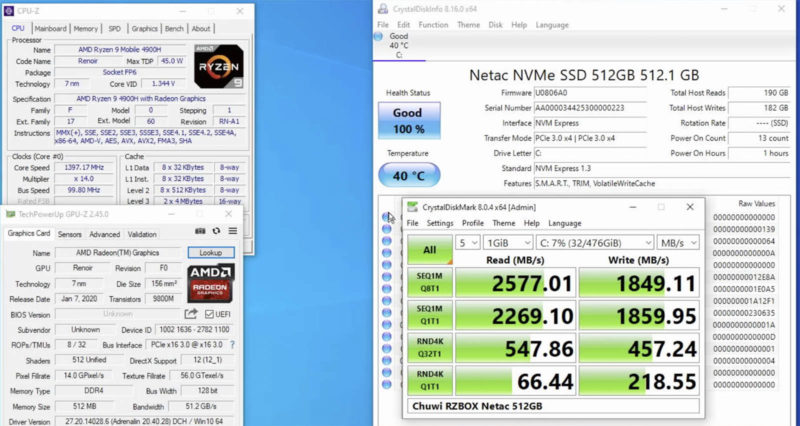
We also stuck a CPU-Z and GPU-Z screenshot in there as well, but this is an AMD Ryzen 9 4900H system.
CHUWI RZBOX Linux Performance
Instead of going through the entire Linux-Bench test suite, we are going to show a few performance and power numbers here to give a general sense of performance. This also gives us the opportunity to test with Linux/ Ubuntu instead of just Windows.
Python Linux 4.4.2 Kernel Compile Benchmark
This is one of the most requested benchmarks for STH over the past few years. The task was simple, we have a standard configuration file, the Linux 4.4.2 kernel from kernel.org, and make the standard auto-generated configuration utilizing every thread in the system. We are expressing results in terms of compiles per hour to make the results easier to read:
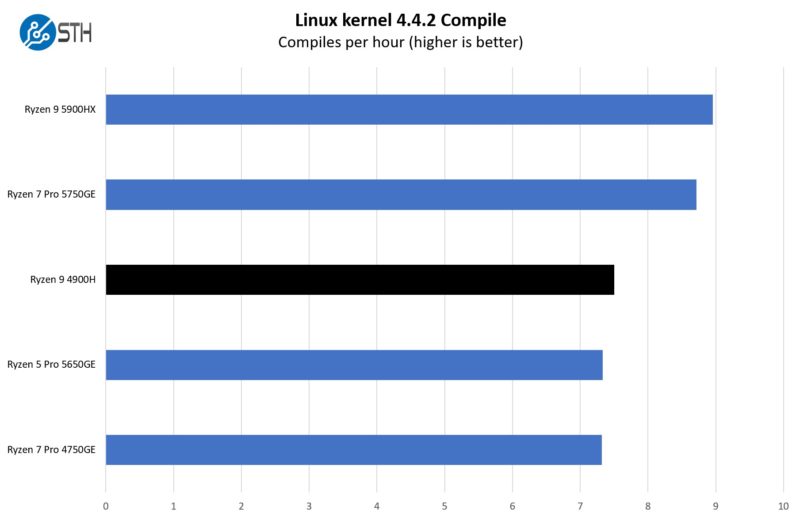
Performance is certainly above both the 8 core Ryzen 7 Pro 4750GE, effectively a lower-TDP part than the Ryzen 9 4900HX as well as the newer Ryzen 5 Pro 5650GE. The AMD Ryzen 9 4900U has extra power and thermal headroom, so it does offer a small performance bump.
7-zip Compression Performance
7-zip is a widely used compression/ decompression program that works cross-platform. We started using the program during our early days with Windows testing. It is now part of Linux-Bench.
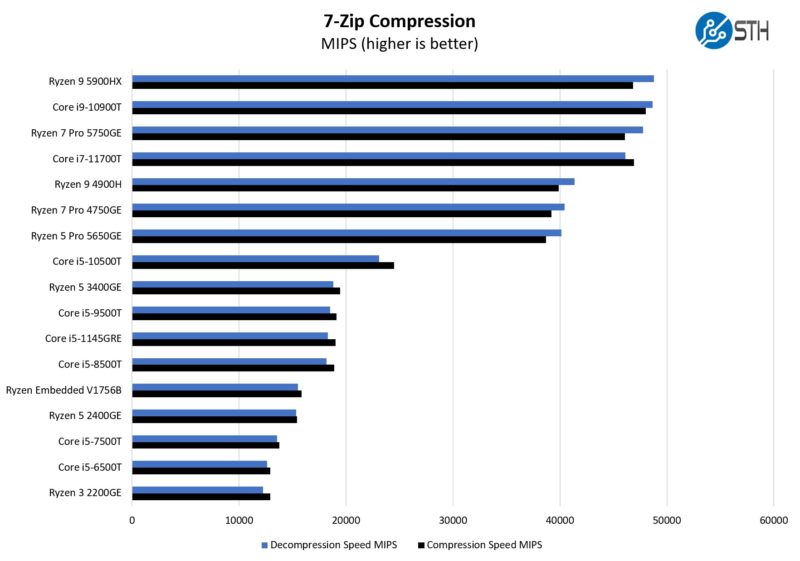
The 7zip compression benchmarks show us that we are below a few of the higher-end Intel Core offerings from the 10th and 11th generations as well, but more akin to higher-end 8 cores parts there than lower-end Intel parts.
OpenSSL Performance
OpenSSL is widely used to secure communications between servers. This is an important protocol in many server stacks. We first look at our sign tests:
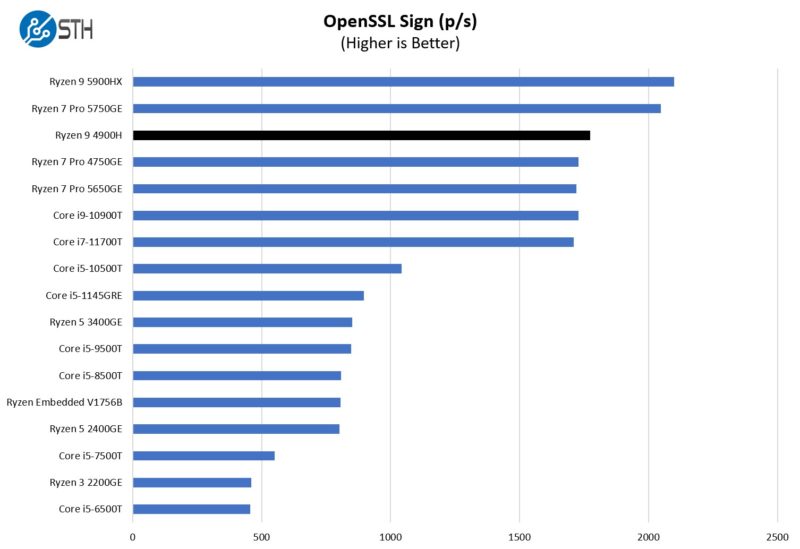
Here are the verify results:
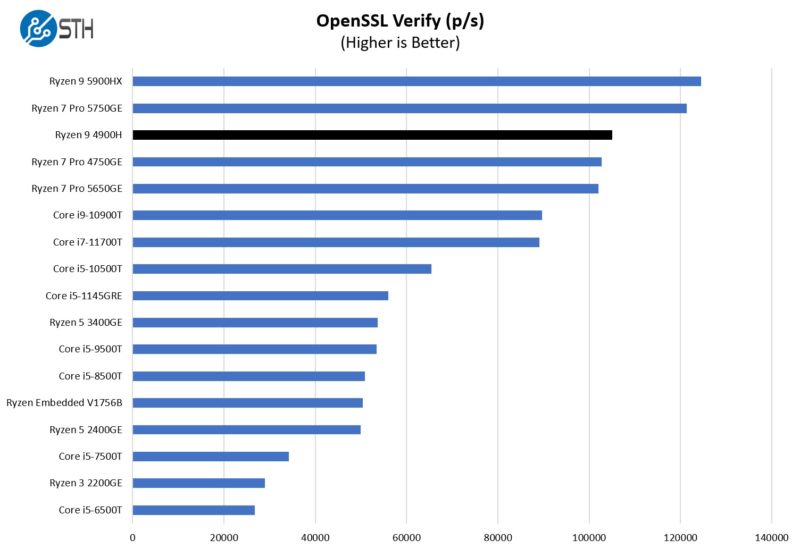
In the world of mini PCs, both the AMD Ryzen 7 Pro 5750GE as well as the Ryzen 9 5900HX are notably faster owing to the Zen 3 architecture switch.
This is all good performance, but again remember that most of our data in this segment is coming from 1L PCs that are half the size and lower power consumption.
On that note, let us get to power consumption.
Power Consumption
Idle power consumption on 120V power we saw around 11-14W idle. However, we could get lower than that. Again, we do see power consumption creep slightly higher over time if dust accumulates in the fan/ heatsink and we had a new unit here. For our testing, we used the 45W TDP as the standard, but one can push TDPs lower and we got into the 6-8W idle range with some BIOS tuning.
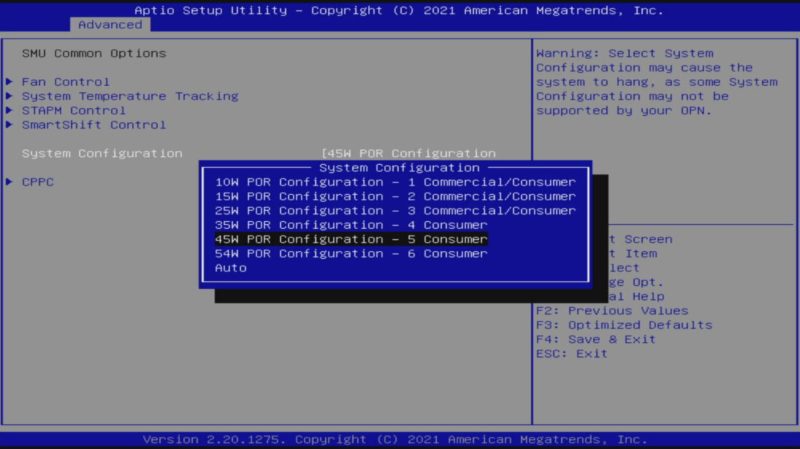
The maximum we saw was around 80W which was quite surprising. Even using a 45W TDP POR, the power consumption was up considerably compared to the 35W 1L PCs we test that usually use under 60W. One can suggest that it is only 20W, and one gets more performance, but it is still 20W more.
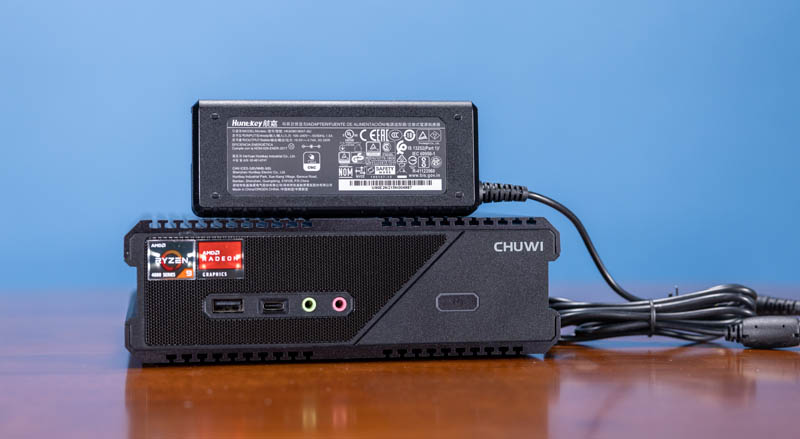
One nice feature is that the PSU is a 90W and is relatively small. We are going to see a Project TinyMiniMicro node with a 230W PSU that is huge soon. Also, it is a 19V PSU so it is in some ways easier to power than the TinyMiniMicro nodes with vendor-specific plugs.
Next, let us get to our key lessons learned and conclusion.




Do these guys do DASH? I have to admit that my impression of Realtek’s DASH implementation(on some AMD-based thinkpads; T14 gen1s) was…rough…; but given that Realtek is both the typical vendor for minimum-viable-NIC and what seems to be the de-facto standard for DASH on AMD client platforms it seems worth knowing if this device is Realtek-as-in-it-was-cheapest or whether they sprang for the DASH supported SKU.
Great to see some reviews of those mini pcs. Especially with the TMM devices as reference. Would love to see some of the minisforum pcs looked at.
I see them as a different segment. Though there are some that might brige the gap a little. Like the asrock 4×4, gigbayte and asus units.
The asrock units would be especially interesting for you to look at as they are still aimed at business use cases . Also asrock’s track record of the recent past seems to usually offer the most recent cpu-series.
I’d like to second fuzzyfuzzyfungus’s question about DASH.
@Patrick
Honest question, regarding Chuwi showing “sold out”, do you prefer
1) they tell you “sold out” when they aren’t able to fulfill orders, or
2) your recent experience with HP, where they accept your cash, give you an estimated shipping date that they aren’t able to meet, then keep pushing the date?
Pretty sure DASH requires Ryzen Pro, so I doubt it has it.
I’ve tried DASH and it seems a lot less mature than AMT does.
I don’t see a connector on the back for mounting external antennas, so presumably the antennas are internal? Which begs the question: can this do 6GHz? If not, then the Wi-Fi 6E support on the card seems moot…maybe they’re building a 2.4/5GHz machine (per the specs) and simply managed to get a good deal on the AX210?
All of this and no HDMI specs? 4k60 support is the most important spec for mini PCs like this as they’re likely to be used in HTPC setups. I don’t care about 95% of the specs listed in this review, the most important one is left out.
@Philippe, 4K@60Hz is visible in the Amazon listing. I went to Chuwi’s site to look it up for you, and even there clicking on MiniPC -> RZBox takes you to the Amazon listing.
Aren’t like all AMD Ryzen and Intel Core systems from 2020 and newer 4K@60Hz?
@Elijah Smith, you would be surprised how many new laptops and SFF PCs have older HDMI 1.4 and lack DP via USB-C. I guess enough customers are clueless that manufacturers figure they can save a few bucks since what the customer doesn’t know won’t hurt them. Try finding an affordable AMD system with USB-C video out and HDMI 2.0 or better. It’s basically $699+ from HP and Asus. Lenovo and others are a serious mixed bag.